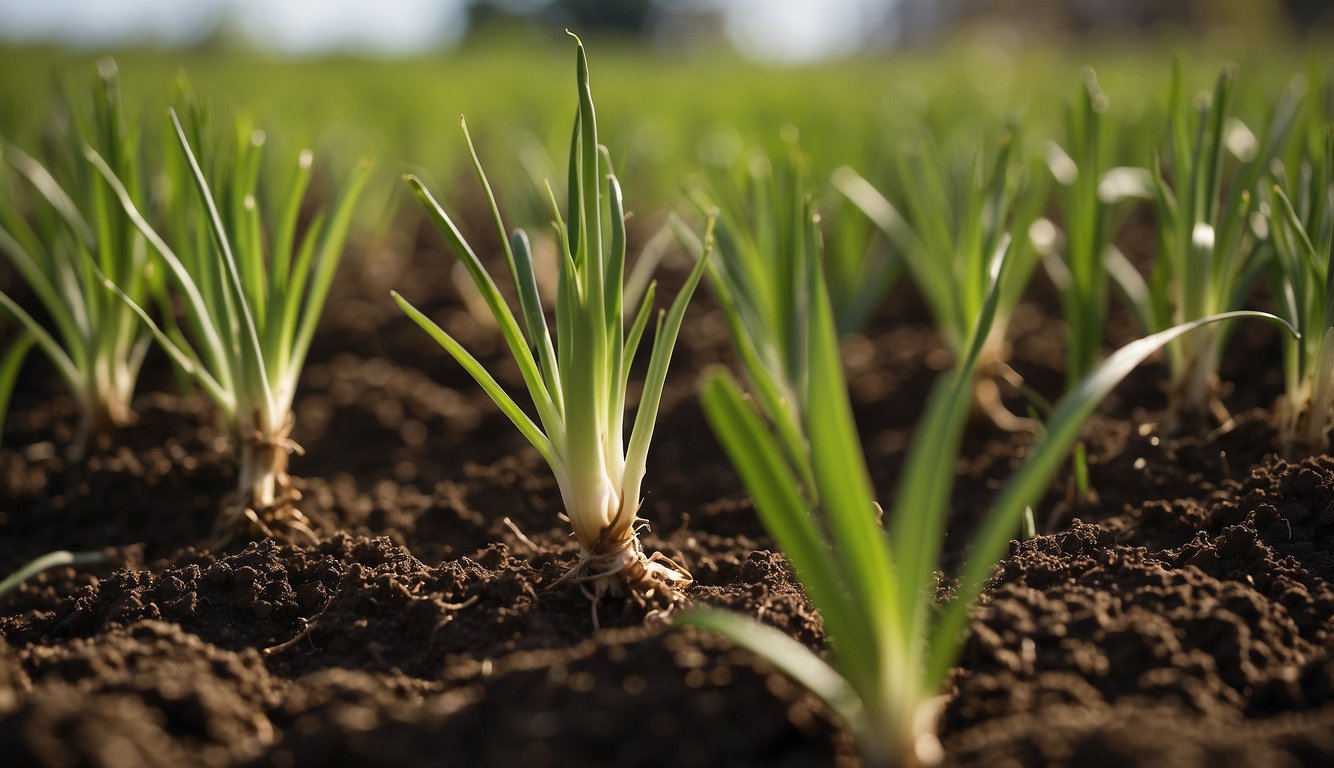TheHerbProf.com is a treasure trove of knowledge for those interested in natural healing and herbal remedies. The website is run by Paul Johnston MD. A naturopathic who has not only received extensive education in the field but also has personal experience in self-healing.
Growing onions in 5 gallon buckets is a popular option for gardeners who lack space or have poor soil quality in their yards. It is a convenient and space-saving method of growing onions, especially for those who live in apartments or have limited yard space. Using 5 gallon buckets to grow onions can be a great way to get fresh, homegrown onions without the need for a large garden plot.
To grow onions in 5 gallon buckets, you will need to make sure that the soil is well-draining and that the bucket has adequate drainage holes. Onions require a lot of moisture, so it is important to keep the soil consistently moist but not waterlogged. You can grow up to 6-8 onions in a 5 gallon bucket, but using a larger container will allow you to grow more. With the right conditions, you can grow onions in 5 gallon buckets just as successfully as you would in a traditional garden bed.
Choosing the Right Bucket – Can You Grow Onions in 5 Gallon Buckets?
When it comes to growing onions in 5-gallon buckets, choosing the right bucket is crucial. In this section, I will discuss the two most important factors to consider when selecting a bucket: size and type, and drainage requirements.
Bucket Size and Type
The first thing to consider when selecting a bucket is its size. A 5-gallon bucket is the perfect size for growing onions. However, keep in mind that the bucket should be at least 10 inches deep to provide enough room for the onions and their roots to grow under the soil. Additionally, make sure to choose a bucket that is wide enough to accommodate the number of onions you want to grow.
The type of bucket you choose is also important. Food grade buckets are the best option for growing onions since they are made from high-density polyethylene (HDPE) and are safe for growing food. Avoid using buckets that were previously used to store chemicals or other non-food items.
Drainage Requirements
Proper drainage is essential for growing onions in buckets. Without adequate drainage, the soil can become waterlogged, which can lead to root rot and other problems. To ensure proper drainage, drill several drainage holes in the bottom of the bucket using a drill. Make sure to space the holes evenly to allow water to drain evenly.
In addition to drainage holes in the bottom of the bucket, you can also drill holes around the sides of the bucket. This will allow excess water to drain out of the bucket more easily. However, be careful not to drill too many holes, as this can cause the soil to dry out too quickly.
By choosing the right size and type of bucket and ensuring proper drainage, you can create the ideal growing environment for your onions.
Preparing the Soil
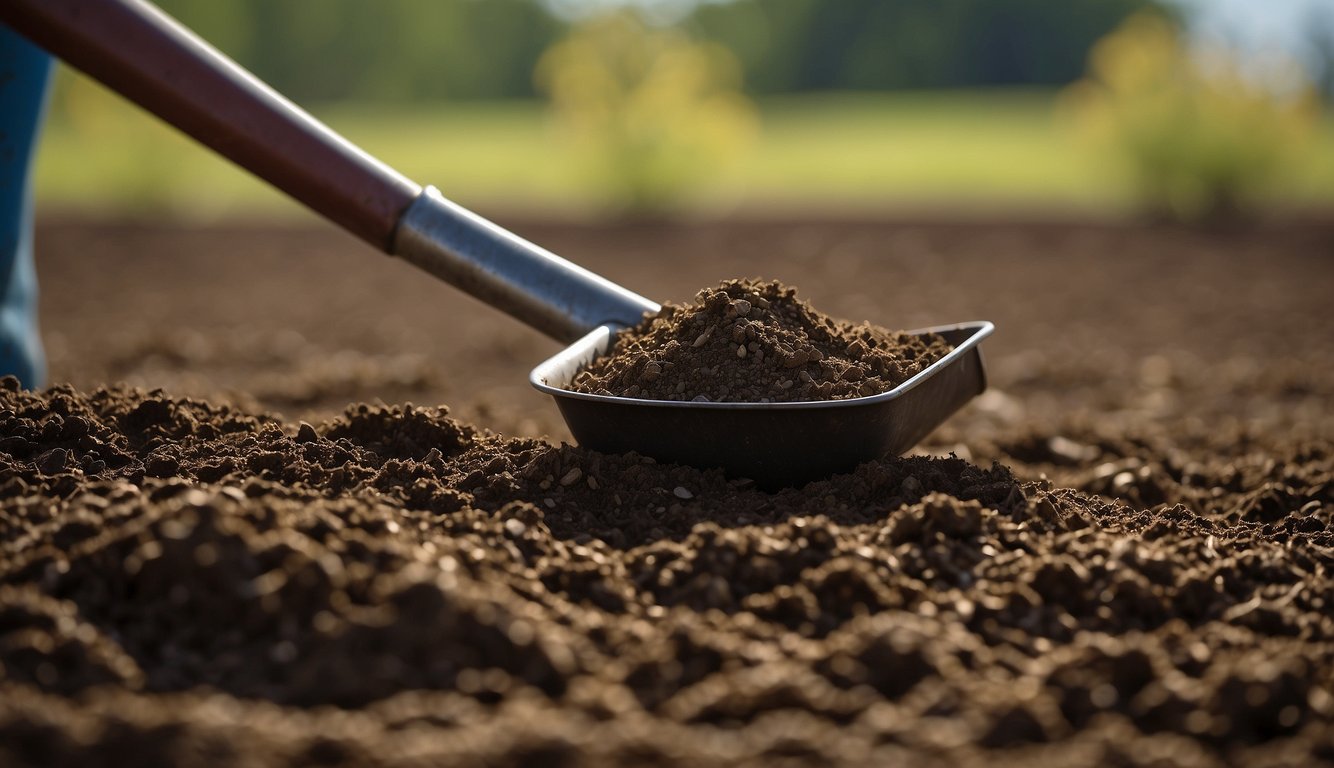
When it comes to growing onions in 5 gallon buckets, preparing the soil is crucial for a successful harvest. In this section, I will cover the soil composition, pH levels, and nutrients required for growing onions in a container.
Soil Composition – Can You Grow Onions in 5 Gallon Buckets?
The first step in preparing the soil is to choose the right potting soil. A good quality potting soil should be light, well-draining, and rich in organic matter. I recommend using a potting mix that contains peat moss, perlite, and vermiculite. These ingredients will provide good aeration, drainage, and moisture retention, which are essential for growing healthy onions.
It’s important to note that onions prefer a slightly acidic soil with a pH level between 6.0 and 6.5. If the soil is too alkaline, the onions may not grow properly. To adjust the pH level, you can add sulfur or aluminum sulfate to the soil.
pH Levels and Nutrients
Onions require a variety of nutrients to grow properly. A good potting soil will contain some nutrients, but you may need to add more depending on the quality of the soil. I recommend adding compost to the soil to provide additional nutrients. Compost is rich in organic matter and contains a variety of nutrients that are essential for plant growth.
In addition to compost, you can also add a slow-release fertilizer to the soil. A balanced fertilizer with equal amounts of nitrogen, phosphorus, and potassium is ideal for growing onions. Be sure to follow the instructions on the fertilizer package and don’t over-fertilize, as this can damage the plants.
Preparing the soil is an important step in growing onions in 5 gallon buckets. By choosing the right potting soil, adjusting the pH level, and adding compost and fertilizer, you can provide your onions with the nutrients they need to grow healthy and strong.
Selecting Onion Varieties – Can You Grow Onions in 5 Gallon Buckets?
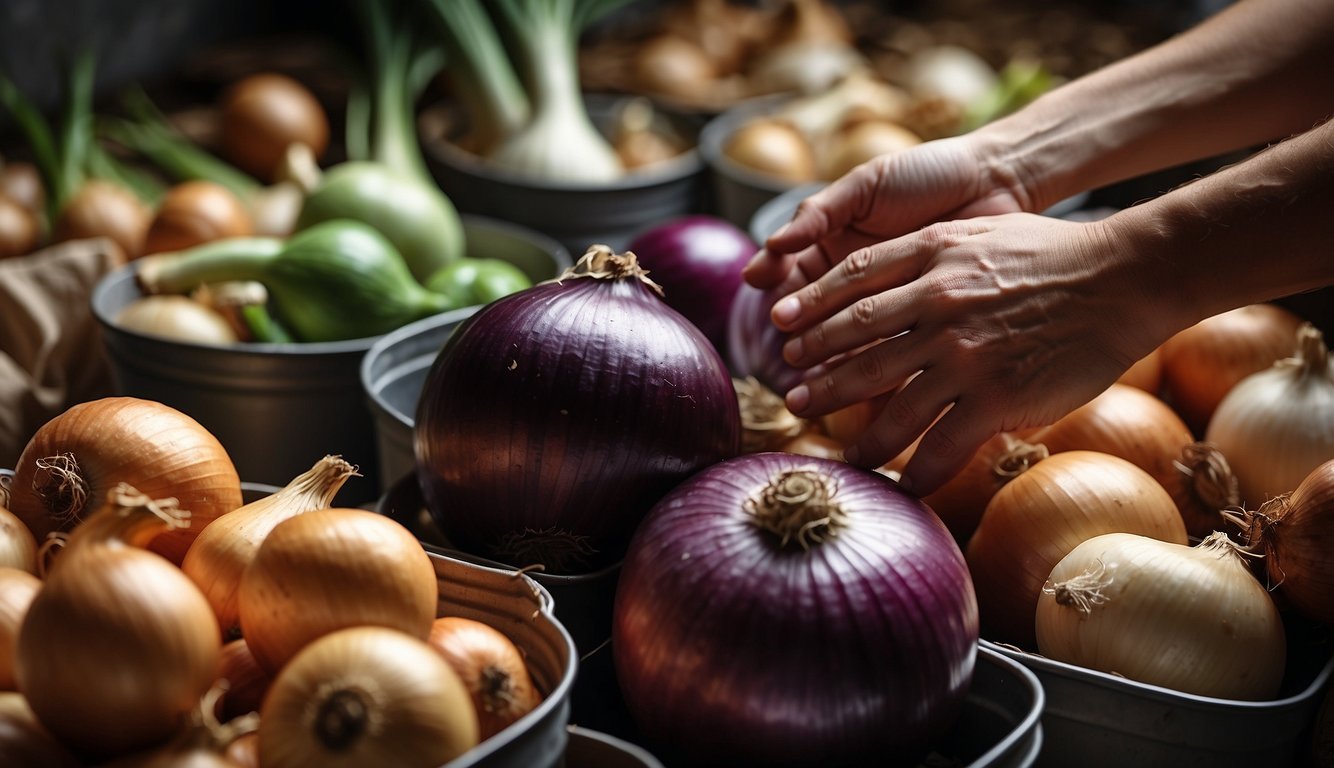
Growing onions in a 5-gallon bucket is possible, but it is important to choose the right type of onion variety to ensure a successful harvest. When selecting onion varieties, there are a few key factors to consider.
Long-Day vs Short-Day Onions – Can You Grow Onions in 5 Gallon Buckets?
Onions are classified as either long-day or short-day varieties based on the number of daylight hours required for bulb formation. Long-day onions require 14-16 hours of daylight to form bulbs, while short-day onions require 10-12 hours of daylight.
For those living in the northern hemisphere, it is best to choose long-day onion varieties. These onions require a longer period of daylight to form bulbs, which is ideal for the longer days of summer. On the other hand, short-day onion varieties are more suitable for those living in the southern hemisphere, where daylight hours are shorter.
Seed, Sets, or Seedlings
When it comes to planting onions, there are three main options: seeds, sets, or seedlings.
Seeds are the most economical option, but they require a longer growing period. Onion sets are small, immature bulbs that are easy to plant and grow quickly. Seedlings are the most convenient option, but they can be more expensive than seeds or sets.
When growing onions in a 5-gallon bucket, it is recommended to use either onion sets or seedlings. These options are better suited for container gardening and will produce a higher yield in a smaller space.
Overall, selecting the right onion variety is crucial for a successful harvest. By considering factors such as long-day vs short-day onions and the type of planting material, you can ensure that your onions thrive in a 5-gallon bucket.
Planting Onions in Buckets – Can You Grow Onions in 5 Gallon Buckets?
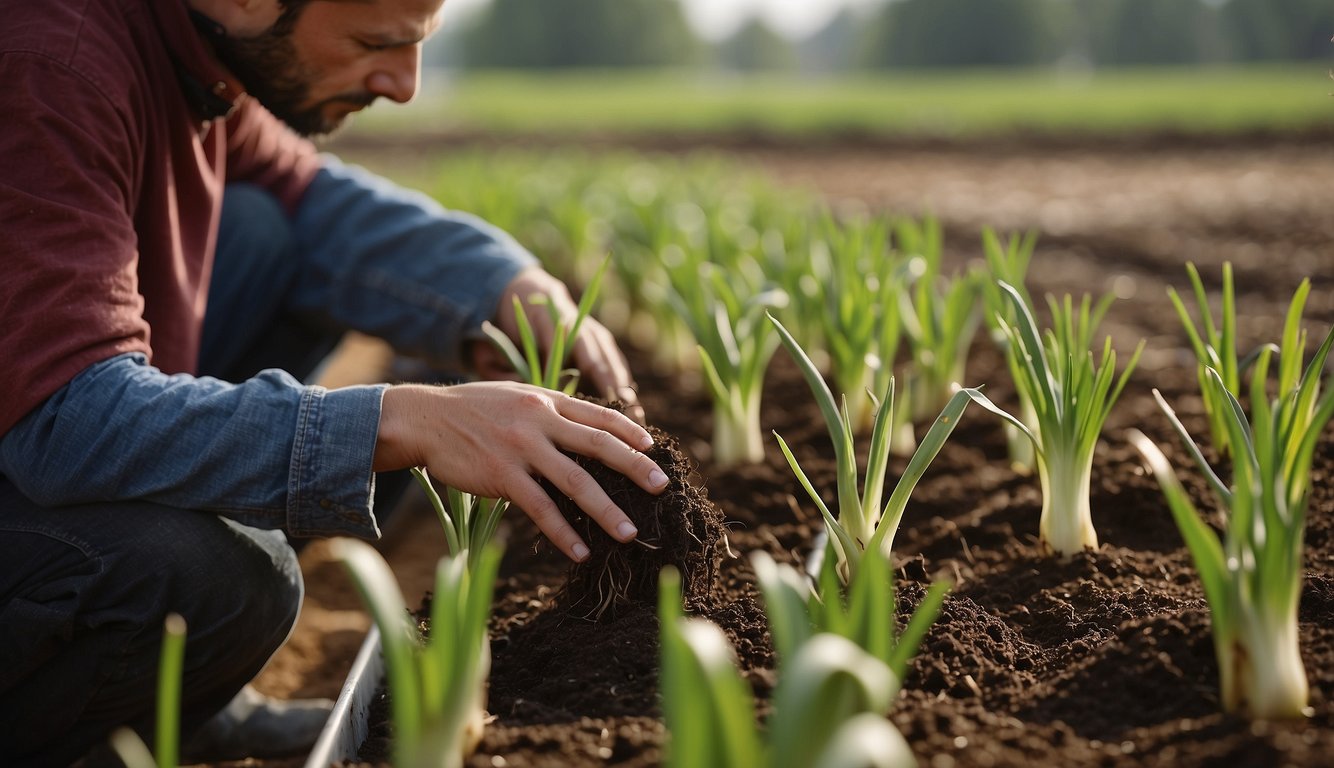
Growing onions in 5-gallon buckets is a great way to have fresh onions without needing a lot of space. Here are some important things to keep in mind when planting onions in buckets.
Timing and Spacing – Can You Grow Onions in 5 Gallon Buckets?
Onions are a cool-season crop that can be planted in early spring as soon as the soil can be worked. The exact timing will depend on your location and last frost date, so be sure to check with your local extension office or gardening resource to find out the best time to plant in your area.
When planting onions in a 5-gallon bucket, it’s important to space them properly to ensure they have enough room to grow. Onions should be spaced about 4-6 inches apart in the bucket. This will allow each onion to have enough space to grow and develop properly.
Planting Depth and Technique
When planting onions in a bucket, make sure to fill the bucket with good quality soil that is rich in organic matter. Onions prefer well-draining soil, so make sure the soil is not too compacted. You can also add some compost to the soil to provide additional nutrients for the onions.
Plant the onion sets about 1 inch deep in the soil. Make sure to plant the onion sets with the pointed end facing up. Cover the onion sets with soil and water the bucket well.
As the onions grow, make sure to keep the soil moist but not too wet. Onions prefer consistent moisture, so make sure to water them regularly. You can also add a layer of mulch to the top of the soil to help retain moisture and keep the soil cool.
Growing onions in 5-gallon buckets is a great way to have fresh onions without needing a lot of space. By following these tips for planting onions in buckets, you can enjoy a bountiful harvest of fresh onions in no time!
Caring for Onion Plants – Can You Grow Onions in 5 Gallon Buckets?

Growing onions in 5 gallon buckets is a great way to enjoy fresh onions without the need for a large garden. However, to ensure the success of your onion plants, you need to take care of them properly. Here are some tips on how to care for onion plants in 5 gallon buckets.
Watering and Moisture Control – Can You Grow Onions in 5 Gallon Buckets?
Onion plants need regular watering to thrive. Make sure the soil is moist but not waterlogged. Overwatering can lead to root rot, while underwatering can cause the onions to become dry and tough. To prevent waterlogging, make sure your bucket has adequate drainage holes.
One way to control moisture is to use a moisture meter to monitor the soil’s moisture level. Aim to keep the soil consistently moist but not waterlogged. Water your onion plants deeply once a week, or more often during hot, dry weather.
Sunlight and Location
Onion plants need full sun to grow properly. Choose a sunny spot for your 5 gallon bucket. If you don’t have a sunny spot, you can use grow lights to provide artificial sunlight.
Onion plants also need good air circulation to prevent fungal diseases. Avoid placing your bucket in a damp, shady area. Instead, choose a location with good air circulation.
Fertilization and Feeding
Onion plants need adequate nutrients to grow properly. Use a balanced fertilizer with a ratio of 10-10-10 or 20-20-20, which contains nitrogen, phosphorus, and potassium.
Apply the fertilizer according to the manufacturer’s instructions. Over-fertilizing can lead to excessive foliage growth at the expense of bulb growth.
In addition to fertilizer, you can also use compost or well-rotted manure to feed your onion plants. Apply a layer of compost or manure to the soil surface and gently work it into the soil.
By following these tips on watering, sunlight, and fertilization, you can ensure the success of your onion plants in 5 gallon buckets.
Managing Pests and Diseases – Can You Grow Onions in 5 Gallon Buckets?
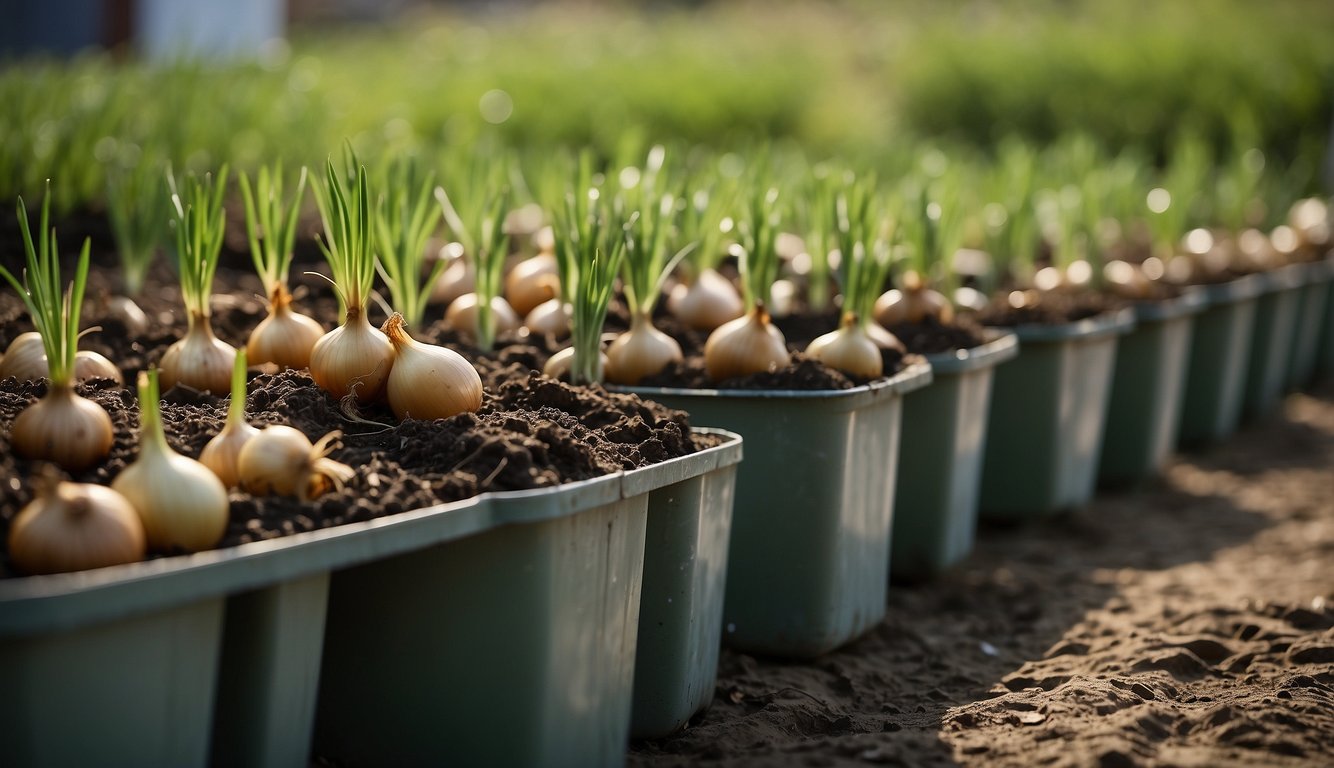
As with any plant, onions are susceptible to pests and diseases. However, with proper care and attention, you can minimize the risk of infestation and keep your onions healthy. Here are some tips for managing pests and diseases when growing onions in 5-gallon buckets.
Common Pests of Onions
Onion maggots, thrips, and cutworms are the most common pests that affect onions. Onion maggots are small, white larvae that feed on the roots of onions, causing stunted growth and yellowing leaves. Thrips are tiny, slender insects that suck the sap from onion leaves, causing them to turn silvery and transparent. Cutworms are caterpillars that feed on the stems of young onion plants, cutting them off at the base.
To prevent infestation, it is important to keep your onion plants healthy and well-fed. Use a balanced fertilizer, such as 10-10-10, and water regularly. Also, avoid planting onions too close together, as this can create a humid environment that is ideal for pests.
Watch on Onion Diseases – Can You Grow Onions in 5 Gallon Buckets?
Onions are also susceptible to a number of diseases, including fungal infections, bacterial infections, and viral infections. The most common diseases that affect onions are Fusarium basal rot, Botrytis leaf blight, and downy mildew.
To prevent the spread of disease, it is important to keep your onion plants clean and dry. Remove any dead or diseased leaves, and avoid overhead watering, as this can create a humid environment that is ideal for fungal growth. Also, avoid planting onions in the same location year after year, as this can lead to a buildup of soil-borne pathogens.
Managing Onion Pests & Diseases – Summary List
Here is a summary list of tips for managing pests and diseases when growing onions in 5-gallon buckets:
- Use a balanced fertilizer, such as 10-10-10, and water regularly to keep onion plants healthy and well-fed.
- Avoid planting onions too close together, as this can create a humid environment that is ideal for pests.
- Remove any dead or diseased leaves, and avoid overhead watering to prevent the spread of disease.
- Avoid planting onions in the same location year after year to prevent a buildup of soil-borne pathogens.
By following these tips, you can help ensure that your onions stay healthy and productive, even in a small space like a 5-gallon bucket.
Harvesting and Storing Onions – Can You Grow Onions in 5 Gallon Buckets?
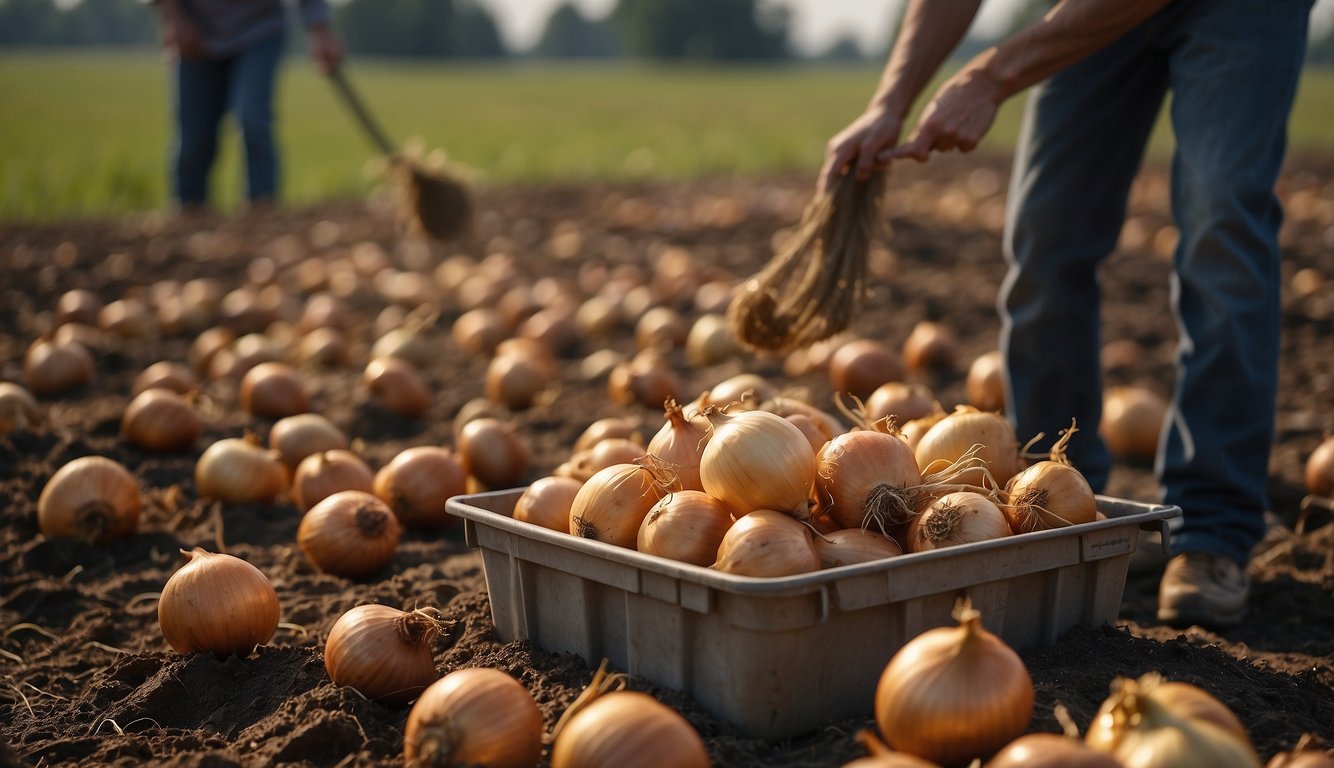
As the onion bulbs mature, they develop a papery outer layer and the tops start to yellow and fall over. This indicates that the onions are ready to be harvested. However, it is important to harvest onions at the right time to ensure that they store well.
When to Harvest – Can You Grow Onions in 5 Gallon Buckets?
Onions should be harvested when the tops have fallen over and started to dry out. This usually happens in late summer or early fall, depending on when you planted them. To check if the onions are ready, gently push the soil away from the bulb and check the size of the bulb. If the bulb is the size of a golf ball or larger, it is ready to be harvested.
It is important to harvest onions when the weather is dry. Wet weather can cause the onions to rot in storage. If the weather is wet when the onions are ready to be harvested, leave them in the ground for a few more days to dry out.
Curing and Storage
After harvesting, the onions need to be cured before they can be stored. Curing is the process of drying the onions in a warm, dry place for several weeks to toughen the outer layer and extend their storage life.
To cure onions, spread them out in a single layer in a warm, dry, well-ventilated area such as a garage or shed. Avoid direct sunlight as it can cause the onions to sunburn. Leave the onions to cure for 2-3 weeks, turning them occasionally to ensure even drying.
Once the onions are cured, cut off the tops and roots and brush off any loose dirt. Store the onions in a cool, dry, well-ventilated area such as a pantry or cellar. Do not store onions near potatoes as they release moisture and gases that can cause onions to spoil. Onions can be stored for several months if they are properly cured and stored.
Harvesting and storing onions is a simple process that requires a bit of patience and attention to detail. By following these simple steps, you can ensure that your onions are ready to use whenever you need them.
Advantages of Bucket Gardening – Can You Grow Onions in 5 Gallon Buckets?

As an avid gardener with limited space, I have found that bucket gardening is a great solution for growing plants in a small area. There are several advantages to using buckets for gardening, which I will discuss below.
Space Efficiency
One of the biggest advantages of bucket gardening is that it is space-efficient. If you have a small patio or backyard, you can still grow plants by using containers. Buckets are an ideal container for gardening because they are deep enough to accommodate the root system of many plants, yet they are also narrow enough to fit in a small space. You can stack buckets on top of each other to create a vertical garden, which is perfect for small spaces.
Mobility and Control – Can You Grow Onions in 5 Gallon Buckets?
Another advantage of bucket gardening is that it allows for mobility and control. Buckets are easy to move around, which means you can position them in the best spot for your plants. If you have a plant that requires more or less sunlight, you can easily move the bucket to a different location. Additionally, buckets allow for better control over the soil and water conditions. You can easily monitor the moisture level of the soil and adjust it as needed. Buckets also prevent soil erosion and weed growth.
Bucket gardening is a great solution for those with limited space who still want to enjoy the benefits of gardening. Buckets are space-efficient, mobile, and provide better control over soil and water conditions. Whether you have a small patio or a large backyard, bucket gardening is a great way to grow plants and vegetables.
Companion Planting and Crop Rotation

Compatible Plants – Can You Grow Onions in 5 Gallon Buckets?
When growing onions in 5-gallon buckets, companion planting can be an effective way to improve the health and yield of your crop. Companion planting involves growing two or more plants together that benefit each other in some way. Some plants have natural abilities to repel pests or attract beneficial insects, while others can improve soil health and nutrient levels.
Carrots, for example, are a great companion plant for onions. Onions and carrots have different root depths, so they don’t compete for nutrients in the soil. Carrots can also help to improve soil structure, making it easier for onions to grow and absorb nutrients. Additionally, the strong smell of onions can help to repel carrot flies, which can damage carrot crops.
Other compatible plants for onions include potatoes, beans, tomatoes, cucumbers, eggplants, garlic, peas, peppers, and radishes. These plants can help to improve soil health, repel pests, and attract beneficial insects.
Rotation Benefits
Crop rotation is another important practice to consider when growing onions in 5-gallon buckets. Crop rotation involves planting different crops in the same area each year to help prevent soil-borne diseases and pests from building up. It can also help to improve soil health and nutrient levels.
When rotating crops, it’s important to avoid planting onions or other alliums in the same area for at least three years. This is because alliums can attract soil-borne pests and diseases that can damage onion crops. Instead, consider planting crops like tomatoes, peppers, or beans in the same area to help break up the pest and disease cycle.
In addition to crop rotation, it’s important to practice good sanitation when growing onions in 5-gallon buckets. This includes removing any dead plant material and avoiding planting onions or other alliums near each other. By following these practices, you can help to ensure a healthy and productive onion crop.
Tips for Success – Can You Grow Onions in 5 Gallon Buckets?

Growing onions in 5-gallon buckets is a great option for those who have limited space or want to grow onions without a traditional garden. Here are some tips to help you successfully grow onions in a 5-gallon bucket:
Choose the Right Container
When choosing a container for growing onions, it is important to pick one that is at least 10 inches deep and has good drainage holes. A 5-gallon bucket is a great option, but make sure it is not too shallow. Onions need enough space to grow their roots, so a deeper container is better.
Select the Right Onion Plants – Can You Grow Onions in 5 Gallon Buckets?
When selecting onion plants, choose ones that are suitable for container gardening. Some varieties of onions are better suited for container gardening than others. For example, green onions or scallions are great options for container gardening because they do not require as much space as other varieties.
Plant at the Right Time
Onion plants should be planted in the early spring or fall. Planting too early or too late can result in stunted growth or no growth at all. Make sure to check your local climate and planting zone to determine the best time to plant.
Use the Right Soil – Can You Grow Onions in 5 Gallon Buckets?
Onions prefer well-draining soil that is rich in organic matter. Use a high-quality potting mix that is specifically designed for container gardening. Avoid using garden soil, as it may contain pests or diseases that can harm your onion plants.
Water and Fertilize Regularly
Onion plants require regular watering and fertilization to grow properly. Make sure to water your onion plants regularly, but do not overwater them. Overwatering can lead to root rot and other problems. Fertilize your onion plants with a balanced fertilizer every two weeks to ensure they have the nutrients they need to grow.
By following these tips, you can successfully grow onions in a 5-gallon bucket. Container gardening is a great option for those who want to grow their own vegetables but have limited space. With a little bit of effort and the right tools, you can enjoy fresh, homegrown onions all year round.
Bucket Bounty: Can You Grow Onions in 5 Gallon Buckets?
Today, we’re diving into a bucketful of fun: Can you grow onions in 5 gallon buckets?
Now, you might be thinking, “A bucket? Really?” Yes, really! Buckets are a fantastic, space-saving way to grow your own veggies. And onions? They’re perfect candidates!
You see, onions have fairly shallow root systems. This means they don’t need a lot of depth to grow. A 5 gallon bucket provides plenty of space!
But here’s the kicker. Onions love well-drained soil. So, make sure your bucket has drainage holes. It’s like giving your onions their very own mini spa!
And don’t forget, sunlight is key. Onions need at least 6 hours of sun a day. So, place your bucket in a sunny spot and watch your onions thrive!
So, if you’re ready to try your hand at bucket gardening, head over to theherbprof.com. It’s packed with tips and tricks for all your gardening needs. You can check our homepage here!
Remember, folks, gardening is not just about growing plants. It’s about growing joy, one bucket at a time. So, let’s keep planting, keep growing, and keep laughing. Happy gardening!
References – Can You Grow Onions in 5 Gallon Buckets?
Little Herb Encyclopedia, by Jack Ritchason; N.D., Woodland Publishing Incorporated, 1995
The Ultimate Healing System, Course Manual, Copyright 1985, Don Lepore
Planetary Herbology, Michael Tierra, C.A., N.D., Lotus Press, 1988
Handbook of Medicinal Herbs, by James A. Duke, Pub. CRP Second Edition 2007
The Complete Medicinal Herbal, by Penelope Ody, Published by Dorling Kindersley
Check the Following Articles!
Neem Oil Soil Drench: Benefits and Application Guide
Growing Herbs in Pots Outdoors: Bountiful Harvest Tips
Grow Thyme from Cuttings: Simple Propagating Plants
Frequently Asked Questions – Can You Grow Onions in 5 Gallon Buckets?

What is the ideal soil composition for growing onions in containers?
Onions grow best in well-draining soil with a pH level between 6.0 and 7.5. A good soil mix for growing onions in containers is a mixture of peat moss, perlite, and vermiculite. Alternatively, you can use a high-quality potting mix that is designed for growing vegetables in containers.
How do you plant and care for onion bulbs in 5-gallon buckets?
When planting onion bulbs in a 5-gallon bucket, fill the container with soil to about 2 inches below the rim. Plant the onion bulbs about 1 inch deep and 4 to 6 inches apart. Water the soil immediately after planting, and keep the soil moist but not waterlogged throughout the growing season. Fertilize the plants with nitrogen-rich fertilizer every two weeks.
Can onions be successfully grown indoors using containers, and if so, how?
Yes, onions can be grown indoors using containers. To grow onions indoors, choose a large container that is at least 10 inches deep and has good drainage. Fill the container with a well-draining potting mix, plant the onion bulbs 1 inch deep and 4 to 6 inches apart, and water the soil immediately after planting. Place the container in a sunny location or under grow lights.
What type of nitrogen fertilizer should be used for onions grown in containers, and how often?
Onions grown in containers require regular feeding with nitrogen-rich fertilizer to encourage healthy growth and bulb development. Use a balanced, water-soluble fertilizer with a high nitrogen content, such as a 10-10-10 or 20-10-10 formula, and apply it every two weeks throughout the growing season.
How deep should a container be to accommodate the root growth of onions?
Onions have a shallow root system and do not require a deep container. A 5-gallon bucket that is at least 10 inches deep is sufficient for growing onions. However, if you want to grow larger onion bulbs, you can use a deeper container.
Is it possible to grow giant onion varieties in pots, and what special considerations are needed?
Yes, it is possible to grow giant onion varieties in pots. However, you will need to provide the plants with extra nutrients and water to support their growth. Use a container that is at least 12 inches deep and 24 inches wide, and plant the onion bulbs about 6 inches apart. Fertilize the plants with a high-nitrogen fertilizer every two weeks, and water them regularly to keep the soil moist.
